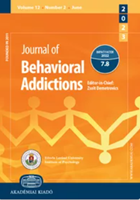Alterations in voxel based morphometry and resting state functional connectivity in men with compulsive sexual behavior disorder in the Sex@Brain study
Alterations in voxel based morphometry and resting state functional connectivity in men with compulsive sexual behavior disorder in the Sex@Brain study
Author(s): Jannis Engel, Athina Gkavanozi, Maria Veit, Jonas Kneer, Tillmann H. C. Kruger, Christopher SinkeSubject(s): Clinical psychology, Behaviorism, Substance abuse and addiction, Health and medicine and law
Published by: Akadémiai Kiadó
Keywords: compulsive sexual behavior disorder; brain imaging; voxel-based morphometry; resting-state functional connectivity; hypersexual disorder; sexual addiction;
Summary/Abstract: Aim: Compulsive Sexual Behavior Disorder (CSBD) is a new category in ICD-11. Research examining underlying brain mechanisms is sparse. Research into neurobiological differences can be helpful in advancing the possibilities of new diagnostic approaches and therapeutic methods. The present study aimed to examine brain matter volume and resting state functional connectivity (rs-FC) in CSBD. Methods: Structural and rs-FC magnetic resonance imaging and data from questionnaires were collected in 30 men with CSBD and 32 age- and education-matched controls. Whole brain voxel based morphometry (VBM) and seed based rs-FC in a-priori defined seeds were analyzed. Results: Structural analyses showed that men with CSBD had significantly increased gray matter volume in the right cerebellum, middle occipital and superior frontal lobe. No differences in rs-FC could be detected when using these brain structures as seed regions in rs-FC. In contrast, literature based rs-FC analysis revealed decreased rs-FC between the right orbital middle frontal cortex (mOFC) and the right gyrus rectus, as well as between left pallidum and right post/precentral gyrus in men with CSBD. In the left amygdala we observed increased rs-FC with precuneus in this group. In addition, most of these measures correlated with symptom severity. Conclusion: Structural findings may underscore the idea that the cerebellum plays an important role in sexual arousal and CSBD. Perhaps, a simultaneous activation of the left amygdala and the precuneus reflects a constant sexual occupation of men with CSBD. Furthermore, lower connectivity between mOFC and gyrus rectus in CSBD may support the assumption that sexual stimuli are evaluated more positively because inhibition is decreased.
Journal: Journal of Behavioral Addictions
- Issue Year: 12/2023
- Issue No: 4
- Page Range: 1032-1045
- Page Count: 14
- Language: English

